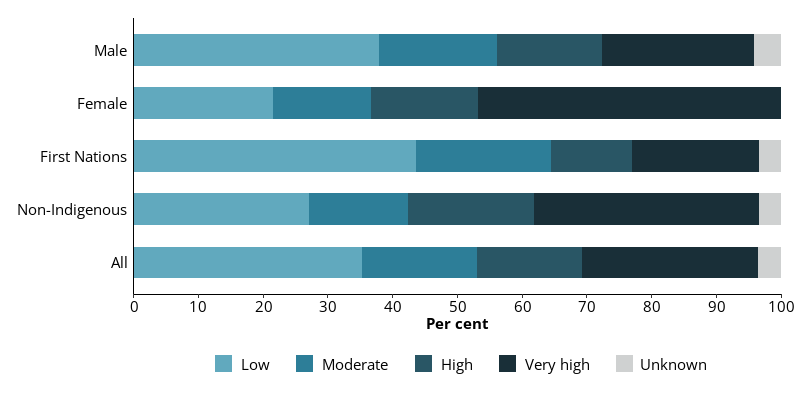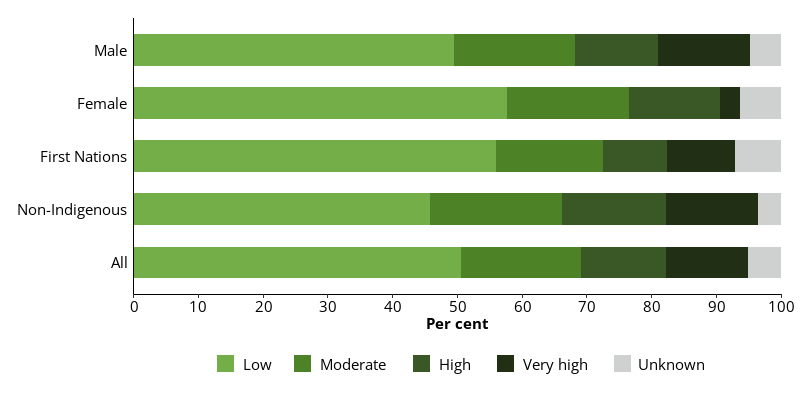Recent psychological distress
The Kessler 10 (K10) scale is a widely used and well-validated survey tool designed to measure participants’ levels of psychological distress through questions about depression and anxiety symptoms over the preceding 4 weeks (Andrews and Slade 2001; Kessler et al. 2002). It has also been shown to be a good indicator of serious mental illness (Kessler et al. 2002).
In 2020–21, 15% of Australians aged 16 to 85 experienced high or very high levels of psychological distress. Females (19%) were more likely to score high or very high levels of psychological distress on the K10 than males (12%), although the differences between the sexes were smaller than those in prison populations (ABS 2022).
Entering and leaving prison can be highly stressful for people in the prison system. The experience of:
- being in prison
- being in the prison environment
- being in relationships with other prisoners
- family, housing and employment issues
- alcohol and other drug use
might all be potential causes of concern and distress for people in the prison system.
Prison entrants and dischargees were asked about their recent psychological distress levels, and their perceived reasons for any distress.
The K10 was included in the surveys completed by prison entrants (for distress levels before prison entry) and by prison dischargees (for distress levels leading up to release).
Prison entrants (43%) were more than 3 times as likely to score high or very high levels of psychological distress as the general population (15%) in 2020–21. Prison dischargees (26%) were also more likely to score high or very high levels of psychological distress than the general population (15%) in 2020–21 (ABS 2022).
More than 2 in 5 (43%) prison entrants scored high or very high levels of psychological distress (Indicator 1.4.5).
Over 1 in 4 (26%) prison dischargees scored high or very high levels of psychological distress (Indicator 1.4.6).
Using the K10 scale, more prison dischargees (51%) scored low levels of psychological distress than prison entrants (35%) (figures 5.6 and 5.7).
Female prison entrants (63%) were more likely than male prison entrants (40%) to score high or very high levels of psychological distress. However, male prison dischargees (27%) were more likely than female dischargees (17%) to score high or very high levels of psychological distress (figures 5.6 and 5.7).
More than a half of non-Indigenous prison entrants (54%) compared with almost one-third (32%) of First Nations prison entrants scored high or very high levels of psychological distress. Non-Indigenous prison dischargees (30%) were more likely than First Nations dischargees (21%) to score high or very high levels of psychological distress (figures 5.6 and 5.7).
Figure 5.6: Prison entrants, K10 level of distress, by sex and Indigenous identity, 2022

Notes
- Proportions are proportions in this data collection only, and not the entire prison population.
- Excludes Victoria, which did not provide data for this item.
- K10 refers to the Kessler 10 scale to measure psychological distress.
Source: Entrants form, 2022 NPHDC.
Figure 5.7: Prison dischargees, K10 level of distress, by sex and Indigenous identity, 2022

Notes
- Proportions are proportions in this data collection only, and not the entire prison population.
- Excludes Victoria, which did not provide data for this item.
- K10 refers to the Kessler 10 scale to measure psychological distress.
Source: Dischargees form, 2022 NPHDC.
ABS (Australian Bureau of Statistics) (2022), National study of mental health and wellbeing, ABS website, accessed 5 July 2023.
Andrews G and Slade T (2001) ‘Interpreting scores on the Kessler Psychological Distress Scale (K10)’, Australian and New Zealand Journal of Public Health, 25:494–497.
Kessler RC, Andrews G, Colpe LJ and Hiripi E (2002) ‘Short screening scales to monitor population prevalences and trends in non-specific psychological distress’, Psychological Medicine, 32(6):959–976.


